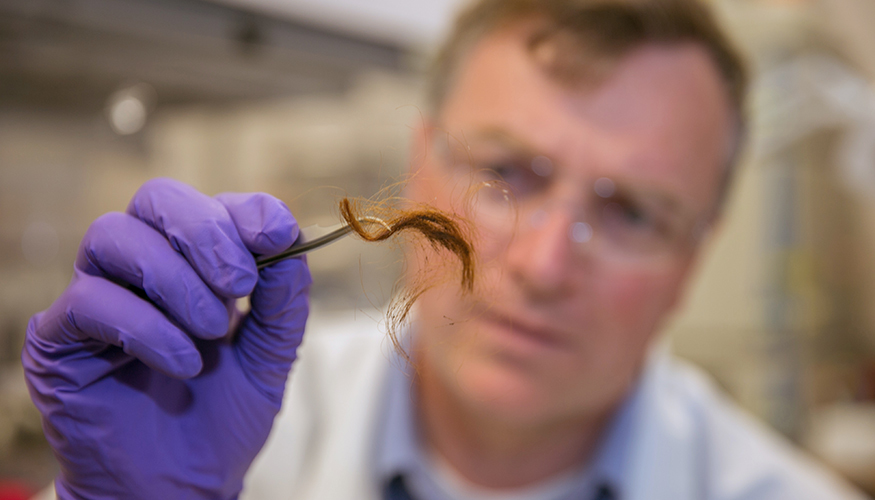Proteome instead of DNA. New way to identify an individual by hair

Biochemist Glendon Parker (Glendon Parker) from the Lawrence Livermore National Laboratory is examining a 250-year-old corpse hair sample from a cemetery in Greater London to identify it. Photo: Julie Russell / LLNL
Accurate identification of a person following the DNA sample left at the crime scene has long been successfully used in forensic science. A DNA sample can be extracted from virtually any biological material: from saliva, sweat, sperm, hair. The problem is that DNA molecules are subject to degradation under the influence of the environment - light, temperature, etc. At a certain level of degradation, DNA amplification by the polymerase chain reaction becomes impossible. What to do?
Biochemists from Lawrence Livermore National Laboratory have developed an alternative method for statistically confirmed identification of a person by hair, without any DNA profiling at all. Scientists have taken the first step to identifying a person by the totality of proteins in the hair, that is, by the human proteome.
A proteome is a collection of proteins expressed in a given cell type in a given period of time under given conditions. It is the proteome that becomes a unique marker for identification of an individual, instead of DNA.
')
Proteins are much more chemically stable than DNA molecules. They have been preserved for centuries in a stable form. That is, we can identify a person's identity several centuries after committing a crime! The new toolkit will significantly expand the capabilities of forensic and archaeologists.
As technology improves, scientists hope that they will be able to extract all the necessary protein markers from a small amount of hair. Ideally - from a single hair. This will be enough to statistically reliably distinguish a particular person among the entire population, that is, 7.3 billion living people and, perhaps, quite accurately select one person among the 100 billion who have already died.
So far, scientific research is at an early stage, but this technology has a very promising potential.
In a published paper, scientists presented the results of an analysis of a proteome in 66 Caucasians, 5 Negroids, 5 Kenyans and 6 skeletons from the remains of the 1750s and 1850s taken from cemeteries in Greater London. A total of 185 protein markers were found in proteomes. And for each person a set of protein markers is unique, which allows it to be clearly distinguished from other people.
The average proteome of the hair in 60 Caucasians (doi: 10.1371 / journal.pone.0160653.s006)
A variety of protein markers in different people is associated with point mutations that occur in the genomes. Because of these point mutations, single nucleotide polymorphism (SNP) is observed, that is, a DNA sequence difference of just one nucleotide (A, T, G or C) with the formation of two or more alleles (for example, T / C). Single nucleotide polymorphisms of the coding sites are of two types: synonymous and non-synonymous. Synonymous SNPs leave the protein's amino acid sequence unchanged, while non-synonymous SNPs change it.
Direct verification of non-synonymous SNP alleles. Illustration from the scientific work "Demonstration of Protein-Based Human Identification Using the Hair Shaft Proteome"
Based on a sample of several dozen people, scientists estimate that the collected number of markers is enough to identify one of about 10,000 people.
Non-synonymous SNP profiles with an estimated profile probability among Caucasoid and Negroid populations. Illustration from the scientific work "Demonstration of Protein-Based Human Identification Using the Hair Shaft Proteome"
Scientists believe that the total number of individual protein markers in the human proteome can be up to 1000 pieces. In addition to hair, these markers are found in other types of tissue, including skin cells, bones, and teeth. Researchers have already begun to study the possibility of identifying people by protein markers in bones and teeth.
Researchers expect that the accuracy of the proteome measurement in the future will allow identifying 1 person out of several billion in all with 90-100 protein markers.
There is a direct connection between protein markers and human DNA, because it is the DNA that controls the expression of specific proteins. Thus, the proteome is a kind of "fingerprint" of DNA. Even in the absence of DNA, it is possible to reconstruct the origin of the individual from this impression.
Now the procedure for compiling a proteome based on a hair sample takes 2.5 days. Scientists are confident that in the future the accuracy of the proteome identification will be increased, and such forensic examination will become a routine procedure.
The scientific article "Demonstration of Protein-Based Human Identification Using the Hair Shaft Proteome" passed a peer-review and published on September 7, 2016 in the open access journal PLOS ONE (doi: 10.1371 / journal.pone.0160653).
Source: https://habr.com/ru/post/397595/
All Articles